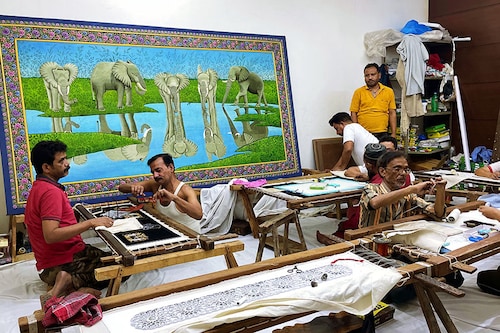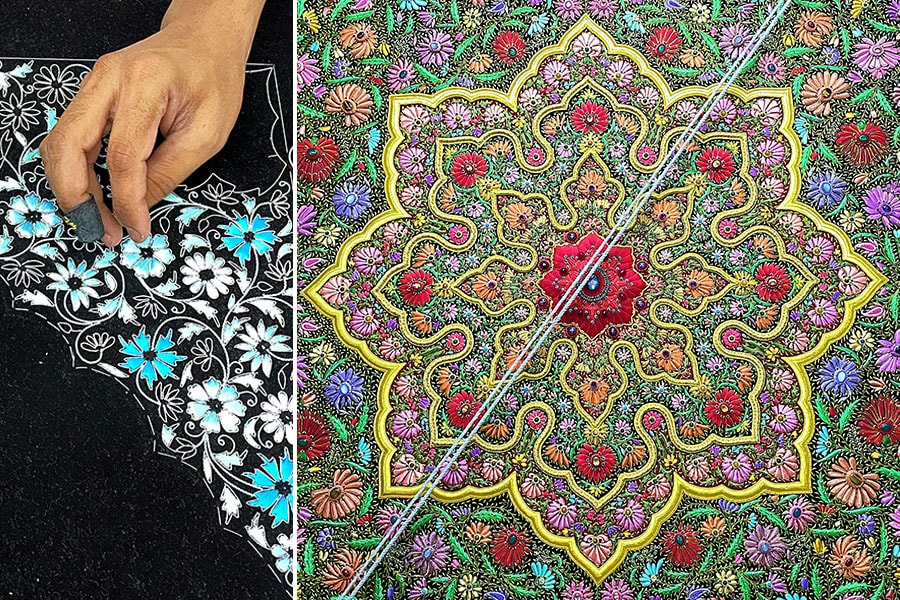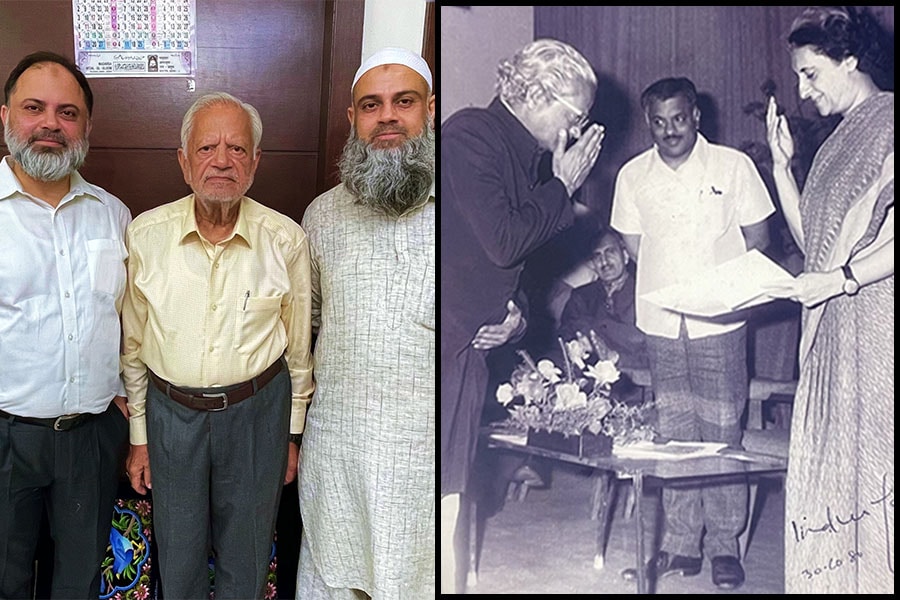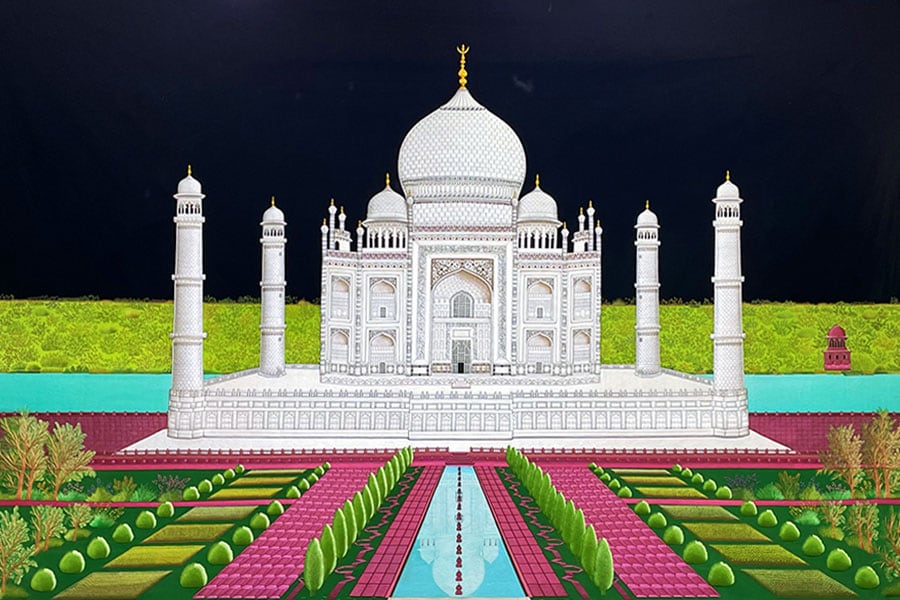The Michelangelo of Zardozi
From crafting masterpieces to sacrificing his eyesight for an embroidered opus depicting Moses, a zardozi artisan's story lives on in the lanes of Agra with younger generations taking the legacy forwa


Zardozi, originally introduced to India by Nur Jahan, the 20th wife of Mughal emperor Jahangir, along with marble inlay work and perfumery, has a rich history. And that history comes alive in the labyrinthine alleys of Basai Khurd, adjacent to Shiv Kothi in Agra, at the humble abode of late Sheikh Shamsuddin. Fondly referred to as Shams, he is renowned for his role in resurrecting the art of zardozi and stands as the sole innovator in India credited with pioneering the technique of 3D zardozi embroidery. In present day, Faizan Uddin, his grandson, carries the torch of a legacy that reshaped the landscape of Indian embroidery.
As with all legacies in Agra, the family"s lineage traces back to the principal architect of the Taj Mahal. "Our connection to Ustad Ahmed Lahori spans 16 generations, a heritage we cherish," Faizan says. Reflecting on his family"s evolution, he adds. “Our ancestors were architects, and it"s often remarked that by the third generation, the work changes. As times changed, so did our craft."
In the era of Nur Jahan, the focus shifted to interiors, then to attire for Mughal women. “This emphasis remained until my great-grandfather"s time. From architecture to interior decoration, and eventually to exquisite garments for royalty, our family"s journey has been one of adaptation." Faizan recalls how his great-grandfather"s final masterpiece was the coronation robe of King George V—a poignant symbol of the family"s couture legacy. "Yet, with time, my grandfather chose a different path."
That was the path of zardozi, a word that originates from Persian roots, a combination of ‘zarb’, meaning gold and ‘dozi’ meaning work, which can be any form of work from gold to silk work (resham dozi). "Prior to Shams, the domain of embroidery lacked the dimensionality we now associate with the craft," Faizan says. "It was solely confined to the traditional zardozi style."
 Zardozi creations begin with silver-plated copper threads, then embellished with layers of semi-precious stones.The world"s largest jewel carpet in making: it will measure 10 by 8 feet with over 100 colours, crafted by 20 artisans. It features precious stones, including star rubies, emerald beads, and sapphires, totalling about 5,000 carats, with an additional 10,000 carats of semi-precious gemstones incorporated so far.
Zardozi creations begin with silver-plated copper threads, then embellished with layers of semi-precious stones.The world"s largest jewel carpet in making: it will measure 10 by 8 feet with over 100 colours, crafted by 20 artisans. It features precious stones, including star rubies, emerald beads, and sapphires, totalling about 5,000 carats, with an additional 10,000 carats of semi-precious gemstones incorporated so far.
Yet, it wasn’t an easy pivot for his grandfather. "My great-grandfather, Ustad Habib Baksh, was renowned for tailoring attire for royal families," Faizan says. It was during the Dilli Darbar of 1912 following the capital"s shift from Calcutta to New Delhi that he made the coronation robe for King George V. While Baksh was deeply entrenched in the regal sphere of tailoring coronation robes and royal garments, his son, Sheikh Shamsuddin, displayed a distinct disinterest in such pursuits.
Faizan recounts a conversation between his great-grandfather and Sheikh Shams. "One day, my great-grandfather confronted Shams, expressing concern about what he perceived as wasted time," Faizan says. "To this, Shams retorted that it was, in fact, his father who was squandering his own time, whereas Shams harboured unique visions yet to be realised." His father issued him a challenge, granting Shams two months to materialise his vision.
"After the allotted time, Shams unveiled his masterpiece—a breathtaking work of art," Faizan reveals. Ustad Habib Baksh and his artisans were summoned to Shams" workshop, the unveiling scheduled for a Friday, a day typically reserved for rest by Muslims. Faizan"s recollection paints a vivid picture of the impact Shams" creation had on his father. "My grandfather recounted with awe how, upon beholding the artwork—a lifelike depiction of a seated tiger—my great-grandfather involuntarily recoiled, momentarily mistaking it for a living creature," he says. "Such was the realism imbued in Shams" creation that it instilled a sense of awe and trepidation in his father." However, in his capacity as a mentor, Ustad Baksh imparted a cautionary note, "While commendable, it"s important not to become overly attached to such pursuits."
Regrettably, Shams found himself engulfed in his craft to an even greater extent, extending his work hours to 18-20 per day. Faizan recollects the toll this dedication took on their family dynamics. "My grandmother, vexed by his prolonged absences, would prepare meals only to be met with Shams" delayed returns," Faizan recounts. "His commitment to perfecting the art of 3D zardozi embroidery was palpable in every moment, as he poured his heart and soul into crafting magnificent pieces."
 From Left to Right Faizanuddin (L), Raisuddin (C) and Fardinuddin (R) son and grandsons of late Shamsuddin.Sheikh Shamsuddin receiving the award for Zari embroidery by Indira Gandhi, then prime minister of India on 23rd March 1973
From Left to Right Faizanuddin (L), Raisuddin (C) and Fardinuddin (R) son and grandsons of late Shamsuddin.Sheikh Shamsuddin receiving the award for Zari embroidery by Indira Gandhi, then prime minister of India on 23rd March 1973
This dedication ultimately culminated in Shams being bestowed with the esteemed Padmashri award, for his contributions to the world of embroidery. Faizan also points out: “My grandfather was invited to the White House three times—first in 1966 by President Johnson, then in 1976 by President Ford, and finally in 1984-85 by President Reagan. And Pandit Nehru called him the Michelangelo of East Asia. "
Today Faizan and his twin brother Fardeen oversee the embroidery business. “Perhaps it will be our daughters who carry the torch forward and explore new avenues," he says as he shows me around the Shams Embroidery workshop, another of the trips organised by the Tajview hotel in Agra, and where his artisans provide a firsthand display of zardozi embroidery. Gesturing towards a threaded padding, he explains, "This is zari work. In the past, artisans used pure gold wires (thick threads). However, as time progressed, they transitioned to silver wires. Currently, we use copper-based wires. These are available in a palette of over 75 colours."
 Shams commenced work on this 16 by 12 ft embroidered Taj Mahal in 1982, a project spanning generations as the family continue its completion. Over 150 thread colours and 500 needles were used in its crafting, with approximately 12,500 needles sacrificed in the process.
Shams commenced work on this 16 by 12 ft embroidered Taj Mahal in 1982, a project spanning generations as the family continue its completion. Over 150 thread colours and 500 needles were used in its crafting, with approximately 12,500 needles sacrificed in the process.
Among the other embroidered masterpieces are a life-sized Taj Mahal, and a piece depicting four elephants, named ‘Reflection’. “In this piece, the elephants standing on the ground exhibit a static reflection, while those submerged in water appear to be in motion. Crafting this piece demanded more than 10 colours and an 11-year effort, with six artisans dedicating 10 hours every day."
The Taj Mahal, I feel, surpasses even the grandeur of its real-life counterpart. Faizan shares its poignant story: “When my grandmother, Akhtari Begum, expressed her desire for a personal masterpiece from my grandfather, he promised her the grandest Taj Mahal in 3D embroidery. Shams commenced work on this 16 by 12 ft embroidery in 1982, a project spanning generations as we continue its completion." He adds, “We"ve employed a proprietary double technique here, with Quranic verses embroidered in their entirety. Over 150 thread colours and 500 needles were used in its crafting."
But it is the Prophet Moses embroidery that has the most poignant tale. Faizan reflects on the monumental effort poured into its creation, spanning 14 years and tragically costing his grandfather his eyesight. "Legend says the creation of Prophet Moses brings with it a burden of misfortune." Faizan"s father Raisuddin completed most of the pieces after Shams lost his sight. But even as some aspirations, “such as depicting Jesus Christ carrying his own dead body, may remain unrealised", Faizan and his team continue to persist in crafting masterpieces to preserve the essence of the art form, highlighting the dedication to perpetuating the tradition of their craft.
First Published: May 25, 2024, 07:33
Subscribe Now